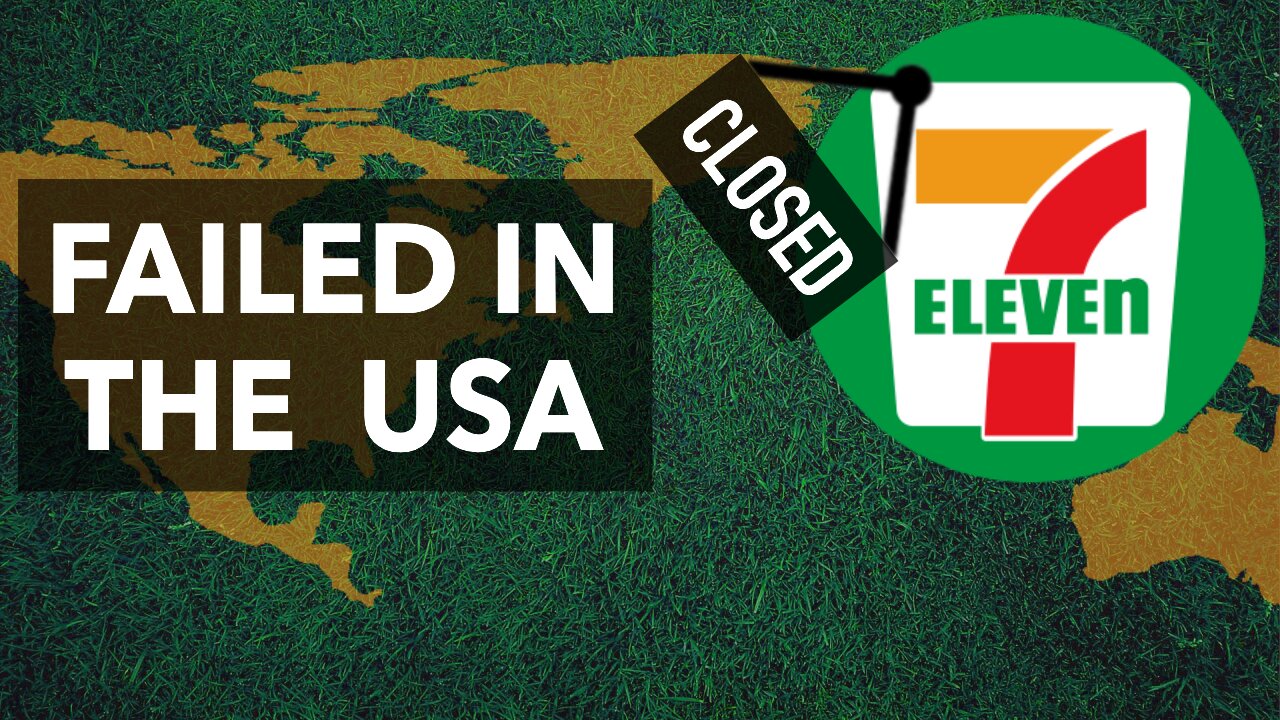Premium Only Content

A Success in Asia but Crashed Out in the U.S: The 7-Eleven Problem
7-Eleven is in trouble in North America, shutting down over 400 stores and retreating from its attempt to dominate the convenience store market. This contrasts sharply with its success in Asia, where it is the world’s largest convenience store chain. Why is a brand so globally recognized struggling to survive in its home market?
The very factors driving its success in Asia are contributing to its failure in North America. 7-Eleven has 85,000 outlets in 20 countries, with Asia accounting for the majority—Japan alone has a quarter of these stores. Yet, the brand's origins are American, dating back to 1927 in Texas, where it started selling ice before evolving into a convenience store offering essentials like milk and bread. Its name comes from its original hours, 7 a.m. to 11 p.m.
Seven-Eleven expanded globally, entering Japan in 1974 through a deal with the Japanese retail giant Ito-Yokado, which later became the majority stakeholder in 1991. The chain has since tailored its identity to suit local markets. In Asia, Seven-Eleven stores are destinations for quick, affordable, fresh meals, which have made them social media sensations. For example, the ham and cheese toastie is iconic in Thailand, and celebrities like Ed Sheeran have spotlighted the brand on platforms like TikTok.
In North America, however, Seven-Eleven has failed to replicate this model. The U.S. stores are known for slurpees, pizza, and hot dogs—far from the fresh and wholesome offerings in Asia. Many are located at gas stations or inner-city areas, and their reputation centers on cheap, processed, and often unappetizing food. Unlike Asia, where food sales dominate, U.S. stores rely heavily on declining categories like cigarettes, which accounted for significant revenue. Since 2019, cigarette sales in U.S. Seven-Elevens have fallen by 26%, leading to closures of underperforming stores.
Rising inflation, high interest rates, and a struggling job market have also hurt middle- and low-income customers, who are limiting discretionary spending. Competition from chains like A.M. P.M. has further intensified the challenge. In response, Seven-Eleven aims to pivot towards offering fresh, nutritious meals, similar to its Asian stores. The goal is to become a go-to destination for quality food workers can bring home—a dramatic shift for the brand.
The problem lies in North America’s food culture, where convenience store fare is synonymous with hot dogs, chips, and sugary drinks, not fresh, healthy options like sushi or rice balls. While there is a health-conscious market, these customers are unlikely to seek out Seven-Eleven, and there are already established chains catering to them. Additionally, the cost of delivering fresh, affordable meals in the U.S. is much higher than in Asia, where a nutritious lunch can cost under $5. This price challenge is significant, as the existing customer base—mostly budget-conscious and struggling financially—may not pay a premium for healthier meals.
Seven-Eleven faces two options: convert its existing customer base by broadening its appeal or rebrand entirely to attract a more affluent clientele. The first option risks alienating loyal customers who frequent the store for traditional products like slurpees and candy. The second option involves an expensive overhaul, including rebranding, marketing campaigns, and upgrading stores to meet the standards set by their Asian counterparts. This would include cleaner stores, better products, and enhanced customer service.
Despite the difficulties, Seven-Eleven has chosen the second path. Inspired by its Japanese stores, it has begun using data to tailor stock to local preferences, introduced fresh daily deliveries, and brought popular Asian items like egg sandwiches to U.S. locations in places like Orange County. However, adopting Asian strategies in a vastly different market may not be enough. North American convenience store culture and food habits present unique challenges that data-driven efficiency alone cannot solve.
Currently, the outlook remains bleak. Sales figures suggest the transformation isn’t resonating with U.S. consumers, and the chain’s attempt to bridge the gap between its Asian success and American expectations appears to be failing. Whether Seven-Eleven can reinvent itself before it runs out of resources remains uncertain.
-

Steven Crowder
3 hours ago🔴 Why Trump & America Will Dominate the Global Trade War
223K159 -
 DVR
DVR
vivafrei
15 hours agoLive with "Bitcoin Jesus" Roger Ver - the Indictment, Law-Fare and the War on Crypto
60.6K7 -
 DVR
DVR
Bannons War Room
1 year agoWarRoom Live
111M -
 LIVE
LIVE
LFA TV
22 hours agoTARIFF TRADE WAR! | LIVE FROM AMERICA 2.3.25 11am
5,727 watching -
 LIVE
LIVE
Caleb Hammer
1 hour agoProfessional Redditor Treats His Wife Like A Pet | Financial Audit
350 watching -
 36:07
36:07
Rethinking the Dollar
1 hour agoTit-for-Tat Trade Wars: Why Gold Is Still Winning (Trade Wars Hurt Your Money!)
4.19K -
 56:02
56:02
Randi Hipper
2 hours agoBITCOIN AT CRITICAL LEVELS AS MARKET CRASHES! LATEST PRICE UPDATE HERE
17.9K1 -
 2:22:37
2:22:37
Matt Kohrs
11 hours agoMARKET CRASH! Trump's Trade War Bloodbath || The MK Show
50.4K8 -
 1:16:40
1:16:40
Graham Allen
4 hours agoCanada WILL LOSE!! Trudeau Enters Trade War With The US! + Zelensky Is Missing 102 BILLION?!
77.9K59 -
 59:17
59:17
Kyle Fortch
3 hours ago $0.86 earnedJon Kilmer: Touring With Kendrick Lamar, Steve Aoki & mike, Creating A Brand | THE ONE SHEET S1E2
15.1K1